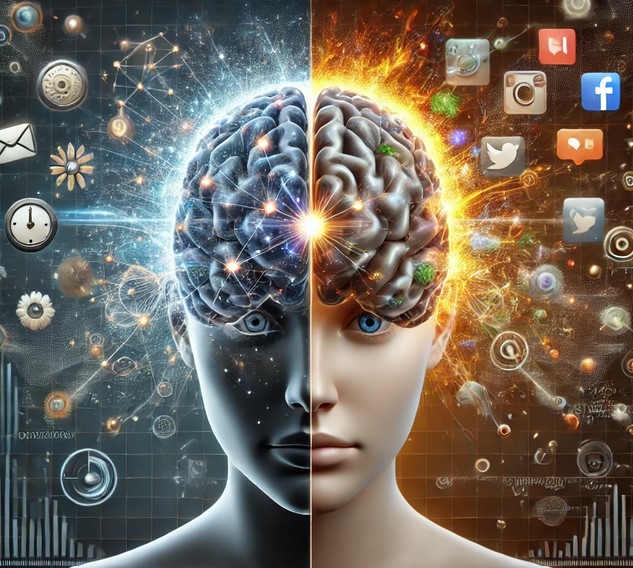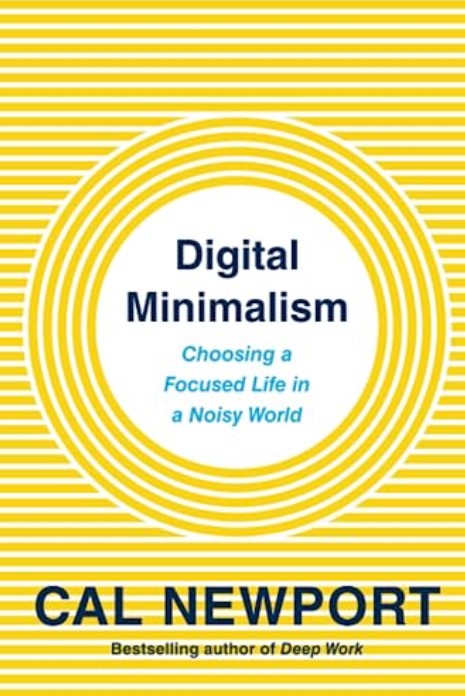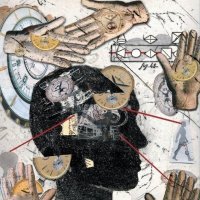Dealing With Distraction
Learning How To Live With Your "Attention Autopilot"

Dealing With Distraction - Setting The Scene
Dealing with distraction in the age of smartphones, social media, and instant gratification is a challenge.
We live in a world of flickering images devoid of real substance. We literally screen-off engagement with the actual world, and all its jagged edges, and reduce it all into a virtual world of sound, pictures, and videos that we carry in our pockets.
In this whirlwind of stimuli, it's easy to feel overwhelmed and disconnected.
Distractions are everywhere, all the time.
I want to start this article with a brief reflection on the original meaning of distraction to understand what is involved in dealing with distraction.
Origin of "Distract"
The word "distract" originates from the Latin verb "distrahere" meaning "to draw in different directions" or "to drag apart".
The modern meaning
is "to draw someone's attention away from something". It means being
pulled away from a task or focus, due to external stimuli or
internal thoughts.
Linked to "Desultory"
"Distract" is closely associated with the word "desultory" which originates from the Latin word "desultorius," meaning "hasty, casual, superficial".
"Desultorius" comes from "desultor," referring to a circus rider who jumped from one galloping horse to another.
The modern meaning is "lacking a clear plan, purpose, or direction; moving haphazardly from one thing to another"... "a lack of focus and a tendency to jump around without a clear goal".
Here's how "distract" and "desultory" are linked:
- While "distract" focuses on being pulled away from a specific task or focus, "desultory" describes a general lack of focus and purpose.
- A person who is distracted might exhibit desultory behavior, as their lack of focus can lead to aimless actions and a lack of purpose.
- For example, a student who is distracted during a lesson might engage in desultory activities, such as doodling or staring out the window, rather than paying attention to the material.
When I was preparing this article I asked myself:
"What words instantly and automatically came into your mind when you think about distraction?"
Then I asked myself:
"What are the emotional drivers that sit behind your tendency to get distracted so easily?"
Then finally I asked myself:
"What do you feel is the root cause of distraction?"
Here are my responses to those questions:
My personal stream of consciousness associations with distraction:
- A compulsion to move fast
- Contentment from momentum
- Stimulation - to be interested and entertained
- Habit, compulsion and algorithms
My emotional drivers that make me get easily distracted:
- Fear of missing out
- Anxiety
- Reassurance ["comfort blanket"]
- Fear
- Boredom
- Fantasy and escape
- Addiction
The root cause of my distraction:
A Quick Dive Into The Neurology Of Distraction & Attention

In dealing with distraction it is helpful if you understand the basic neurology of distraction.
If you know how your brain works and why it does what it does, then you can learn how to make your brain work for you.
2 Different Attention Systems
Your brain is equipped with two different attention systems to deal with the information you receive from the world around you.
We can think of these as:
- "Reactive Attention" - which responds to distractions, and
- "Focused Attention" - which is a focus on one thing to the exclusion of everything else.
Both of these different types of attention are hardwired and each serve a different purpose.
In dealing with distraction it is essential that you understand how your brain functions in this way, and why, and how to consciously apply the appropriate modality.
Reactive Attention
If a helicopter suddenly landed right outside of the room where you are reading this article, you would not make a decision to pay attention to it. Within a fraction of a second, you would automatically and immediately orient your attention system towards the helicopter.
- This automatic “orienting response” is located deep within a complex network of brain regions.
- It is an automatic, instinctive response to novel or significant stimuli.
- This orienting reflex is essential to your survival. To stay safe, you need to react quickly to potential threats in your environment.
However, it isn’t just external stimuli that interrupt your focus with potential threats to your survival.
We frequently interrupt ourselves with input and suggestions from our thought stream [or what in zen is called our "monkey mind" because it is always jumping around from one thing to another].
Focused Attention
Your focused attention system, is located in the prefrontal cortex, or the “executive center” of your brain.
- You use this system when you make a conscious decision to pay attention to one thing to the exclusion of everything else.
- Focused attention also includes "sustained attention", which is when you maintain your focus over a period of time.
- Unlike reactive attention, focused attention is not automatic and is only developed with a lot of practice.
The strength of your focused attention depends upon two things: wiring and practice, because, “whatever the brain does a lot, is what the brain gets good at.”
Your brain’s executive function skills get reinforced the more you use them.
Attention Autopilot
Your brain has an inbuilt, hard wired capability known as "Rhythmic Spatial Attention" which is easier to think of as an "Attention Autopilot".
- What this means is that your brain is skipping between focused attention and your environment.
- It does this automatically to keep you safe and to see if there is anything interesting going on in the external environment, and also in your thought stream, that may require your attention.
- Your focused attention works in very short bursts.
- You are not aware of these gaps in your focused attention because your brain creates the illusion that you are perceiving reality as a continuous movie.
We quite naturally think of focused attention as being laser-like, a continuous stream of attention, but research has shown that focused attention is more like a spotlight that continously dims and comes back on again - several times per second.
In between these bursts of attention, your brain is temporarily distracted as it pauses and scans your environment to see if there is something outside your primary focus of attention that might be more important. If there isn't, it re-focuses back to what you were doing.
For example, while it may seem to you that you are continuously focusing on reading this article, the underlying neurological reality is that you’re zooming in and out of focused attention up to four times per second.
Living With Your Attention Autopilot The good news about your Attention Autopilot is that it will keep you safe. It is continuously scanning your immediate environment for threats. The bad news is that it is also programmed to look out for potentially interesting things to bring to your attention. The worse news is that it doesn't just scan your external environment it also scans your internal thought stream... Like a curious child, your Attention Autopilot will be continuously throwing stuff at you saying: "Hey look at this!" It's good at spotting threats but indiscriminate in what it thinks is "interesting". You can't stop it. It is what is and it does what it does. As the adult in your relationship with your Attention Autopilot, its your responsibilty to train it to leave you alone when you're busy.
Understanding your attention autopilot and framing it as a curious and indiscriminating child raises a number of important factors:
- It makes more sense of the descriptive words we discussed above when looking at the etymology of distraction: to drag apart - hasty, casual, superficial - a lack of focus and a tendency to jump around without a clear goal.
- It shows how vulnerable this "curious and indiscriminating child" is, and how susceptible it is to digital exploitation and manipulation by search engines and social media.
- Given the neuroplasticity of the human brain it shows how easily our cognitive capabilities - our thinking skills - can become degraded if we fail in our attempts at dealing with distraction.
- It also shows how this failure will interfere with our practice of mindfulness.
Training The Curious And Indiscriminating Child
This analogy of viewing your attention autopilot as a curious child raises further important perspectives in your attempts at dealing with distraction:
- Would you allow your life to be dictated to and driven by the indiscriminate whims of a curious child?
- Can you see that as the adult in this relationship it is your responsibility to guide the curious child with values, boundaries and guidelines as to its behaviour?
- Will you accept that as the adult it is your responsibity to protect the curious child from being exploited by the all predators in the digital world who seek to take advantage of it?
Finally, you don't train a curious child by criticising or in any way denigrating its curiousity.
You strike the balance between addressing its behaviour whilst simultaneously affirming its importance and value as a curious child.
Between the stimulus from the curious child and your response to it there is a space, and in that space is your power to choose your response.
The long term impact of your choices can have a major cumulative effect on your life.
I now want to move on and develop this analogy and set out some practical suggestions for how you can apply this in relation to your thinking skills and your mindfulness practice.
Distraction And Its Impact On Thinking Skills
Digital Minimalism

To recap:
- You are hard-wired to be distracted - you have an automatic “orienting response” located deep within a complex network of regions within your brain.
- You can think of this as an "attention autopilot" which is scanning your external and internal environment approximately 4 times per second.
- You can't stop this happening. But you can learn to work with it.
- The primary purpose of your attention autopilot is to alert you to threats to your safety.
- The secondary purpose of your attention autopilot is to look out for novel and potentially interesting things to bring to your attention.
- It has no powers of discrimination or selection. It will just keep on throwing things at you to look at.
- A useful mental model for dealing with distraction is to think of your attention autopilot as a curious and indiscriminate child, to see yourself as the responsible adult, and to adopt effective strategies to allow you as
the curious child
to successfully co-exist with the adult you.
Dopamine Addiction
One further important point to consider in dealing with distraction is dopamine addiction:
Technology companies specifically design apps to deliver “intermittent positive reinforcement” which is a polite way of saying they give you a dopamine hit to keep you addicted to scrolling for more hits.
Dopamine is a neurotransmitter that plays a crucial role in the brain's reward system, which is responsible for feelings of pleasure, motivation, and desire.
Online activities, like social media scrolling, can trigger dopamine release because they offer a constant stream of potential rewards, such as likes, comments, new content, or notifications.
The uncertainty of what you might find next, combined with the potential for positive feedback, makes online interactions highly engaging and addictive.
The Impact Of Distraction On Your Thinking Skills

The impact of digital distraction on your thinking skills is very similar to the over-use of alcohol or other drugs.
Degraded thinking skills
- To personalise this, I know from experience that whenever I have over-indulged in alcohol, my thinking skills are seriously degraded the following day.
- Yes I can function, but only at a lower level. I am only capable of doing "shallow work" - routine and undemanding tasks.
- My capacity for exercising higher cognitive skills is seriously impaired. I have to wait for 24 hours until my head has cleared before I can engage in any task [such as writing this article] that requires deep thinking.
- Dopamine addiction can have the same effect. I have found that allowing myself to become excessively distracted online and incurring the inevitable over-indulgence in dopamine hits has a similar impact on the thinking skills as over-indulgence with alcohol.
Lazy thinking habits
- Repeated and regular superficial and shallow use of the internet, skimming through blogs and articles without reading and developing some cognitive understanding and appreciation of what you have read, leads to lazy thinking habits.
The cost of any form of interruption
- At the thin end of the distraction argument, any form of distraction that interrupts the flow of work causes a significant delay in getting refocused on the task in hand.
- According to Gloria Mark, study lead for “The Cost Of Interrupted Work” it takes an average of 23 minutes and 15 seconds to get back to the task.
- Degraded thinking skills, lazy thinking habits, and repeated distraction produce suboptimal results.
The good news!
- The human brain has the ability to reorganize itself by forming new neural connections throughout life, enabling learning, adaptation, and recovery from injury. This ability is referred to as neuroplasticity.
- The encouraging news is that while people used to believe that the brain became fixed after a certain age, newer research has revealed that the brain never stops changing in response to learning.
- The caveat to that good news is that we have to make the effort to learn and grow our brains!
- We do this by applying our focused attention to setting intentions to modify our behaviour and adopt resourceful and appropriate strategies for dealing with distraction.
- As we modify our behaviour we form new habits and this repetition leads to a dopamine reward. So we replace the dopamine hits of digital distraction with hits for "good behaviour".
An example of working with the curious
indiscriminating child
To return to the analogy of the curious indiscriminating child, I want to share one simple strategy I have developed for when I am deeply engrossed in writing an article and my attention autopilot kicks in with an interruption:
- I acknowledge the curious child and metaphorically thank it for bringing it to my attention, then I tell it that: " I am busy now but I am writing it down and I will return to this later and explore it further - so thankyou."
- Obviously I dont really talk to myself - but I hope you get the point about the thought process!
- I have come to understand that whilst a lot of my curious child's contributions are trivial, some are not and it does come up with some interesting and useful things.
- So I have learned to treat it with respect and review and evaluate all of its contributions - but at a time and in a manner that is convenient for me - and not on demand.
- One final observation on this point: I have also come to realise whilst the curious child is indiscriminating, the results it throws up can be similar to the output of lateral thinking - and so, very useful.
Resource:
Getting Things Done - Your Mind Is For Having Ideas, Not Holding Them
Dealing With Distraction By Adopting A Strategy Of Digital Minimalism

My intention with this article is to try to offer you a different perspective on dealing with distraction and to motivate you to do this.
I now want to offer and recommend some practical resources that I have found very helpful in my attempts at dealing with distraction and especially digital distraction.
Cal Newport is a computer science professor at Georgetown University, who in addition to his academic research writes about the intersection of digital technology and culture:
"I’m particularly interested in our struggle to deploy these tools in ways that support instead of subvert the things we care about in both our personal and professional lives."
The overarching themes of his work can be summarised as:
- Finding focus in an age of digital distraction and cultivating digital minimalism.
- The deliberate cultivation of attention-management skills.
- The practice of “deep work”
In 2019 Newport published: "Digital Minimalism"
I recommend this excellent book summary by Samuel Thomas Davis presenting key action points from the book. Here is a taster:
Distraction And Its Impact On Mindfulness
The Dharma In Distraction

Before I share some practical suggestions about dealing with distraction in relation to your mindfulness practice, I just want to make the following brief observations.
I speak as a long term practitioner of mindfulness practices in the tradition of the late zen master Thich Nhat Hanh and I also have, over many years, had direct expererience of several mainstream Buddhist traditions.
So what I am going to say now may irritate or offend readers who are on one of these paths.
[1] Buddhist practitioners would benefit enormously by having some basic understanding of the neurology of the human brain.
Why? Because it explains in practical terms how and why our brains function in the way that they do.
This relieves the need to absorb so much Buddhist philosophy and teaching and to focus more on the basic practices that rewire our brains and deliver the results we all seek, namely how to stop thinking, and how to awaken and be free of the mind.
I appreciate this is a deeply reductionist view, but it is entirely consistent with the zen approach of direct experience and insight.
[2] There are only 3 things that really matter and these are what you need to master:
- To be able to stop thinking on demand, at any time and in any place. In practical terms this means learning how to disconnect [or unfuse] your observing mind from your thought stream.
- To understand and experience that there really is no independent self. In neurological terms this means understanding the modular brain which is an emergent property of a complex system [your whole brain], and which creates the illusion of a distinct and separate self [your sense of self, your ego].
- To understand and experience the awakened [enlightened] mind. In neurological terms this means to have a balanced brain. In experiential terms: to be free of the effects of your mind, to be unencumbered with thoughts about the past or the future, to be 100% present-moment-aware.
Resources:
Can You Stop Thinking? Discover The Joy Of A Quiet Mind
The Conscious Mind Is Limited - Be Aware And Be Prepared
Who Is In Charge? The Modular Brain
Dying To Self - Dropping Your Ego
Stuck In Seeking - Is The Biggest Block To Being Present
The Stink Of Zen Enlightenment
The Short Cut To The Dharma In Distraction
In the preparation of this article I have reread many Buddhist teachings on how and why distractions arise and their impact on your mindfulness practice, and also about dealing with distraction in your mindfulness practice.
On the basis of the neurological insights we have already covered in this article I think that we can bypass these interminable Buddhist expositions on this subject and get to the heart of the matter right now.
Distractions can interfere with your mindfulness practice. From a cognitive perspective the practical steps outlined above, relating to thinking skills, will give you the structure and discipline to change your behaviour.
From a mindfulness perspective I have found that at root, distraction is all about a desire to be anywhere but here, now.
I have explained above, the neurological [or "brain hardware"] explanation for why your brain behaves as it does.
However, from a "brain software" perspective [your thoughts] this is all about your ego defending itself and throwing up layer after layer of defense mechanisms.

Why does it do this? Because your ego:
- Wants to stay in control of you.
- Wants to perpetuate the illusion that your ego [your innate sense of self] is who you really are.
- Knows that when you see through this illusion, and experience the awakened mind, it will have to take a secondary position.
Traditional mindfulness teaching will tell you to sit with your distractions, and watch them as they appear in your thoughts and emotions, until they subside and disappear.
This is correct, but it does take time and considerable self discipline.
Through many years of practice I have found that the fastest and the most effective way of dealing with distraction is the practice of acceptance.
The resources below are all you need.
Just read, apply, "rinse and repeat"!
Resources:
Here is the basic practice:
Here is the full end-to-end process for:
How To Wake Up - 4 Simple Practices To Help You Wake Up Now

Return from "Dealing With Distraction" to: Walking The Talk
LATEST ARTICLES
Dealing With Distraction - Learning How To Live With Your "Attention Autopilot"
 Living With Your Attention Autopilot The good news about your Attention Autopilot is that it will keep you safe. It is continuously scanning your immediate environment for threats. The bad news is tha…
Living With Your Attention Autopilot The good news about your Attention Autopilot is that it will keep you safe. It is continuously scanning your immediate environment for threats. The bad news is tha…The Time Of Your Life - Recognising Moments Of Alignment For Action
 How will you recognise your moment of alignment for action? In this article I want to look at our relationship with time and in the context of the two main themes of this site, firstly as a thinking s…
How will you recognise your moment of alignment for action? In this article I want to look at our relationship with time and in the context of the two main themes of this site, firstly as a thinking s…The Metagame Approach to Second Order Thinking - 5 Guiding Principles
 How To Position Yourself For Survival & Success In A Complex Environment We treat life as though it is a complicated system, and our thinking skills and mental models are focused on understanding its…
How To Position Yourself For Survival & Success In A Complex Environment We treat life as though it is a complicated system, and our thinking skills and mental models are focused on understanding its…Outcome Over Optics - Long Game Outcomes Over Short-Term Ego Gains
 The Day I Learned To Focus On Outcome Over Optics I have never forgotten the day I learned to focus on outcomes over optics and figured out a very simple way of saving myself several hundred thousand…
The Day I Learned To Focus On Outcome Over Optics I have never forgotten the day I learned to focus on outcomes over optics and figured out a very simple way of saving myself several hundred thousand…The ETTO Principle - Why Near Enough Can Be Good Enough
 How To Balance the Efficiency-Thoroughness Trade Off The ETTO Principle describes the inherent trade-off between working efficiently and working thoroughly. This trade-off is something that affects…
How To Balance the Efficiency-Thoroughness Trade Off The ETTO Principle describes the inherent trade-off between working efficiently and working thoroughly. This trade-off is something that affects…Master The Art Of Drawing The Bow
 Focus On Process Not Outcome In so many areas of our lives, we focus on the outcome, not the process that we follow to achieve it. In the western world, we are conditioned to pay less attention to how…
Focus On Process Not Outcome In so many areas of our lives, we focus on the outcome, not the process that we follow to achieve it. In the western world, we are conditioned to pay less attention to how…And So This Is Christmas
 There Is No Path To Peace - The Path Is Peace Thich Nhat Hanh, the renowned Vietnamese Zen Buddhist monk, teacher, and peace activist, often spoke about peace as a state of being that begins within on…
There Is No Path To Peace - The Path Is Peace Thich Nhat Hanh, the renowned Vietnamese Zen Buddhist monk, teacher, and peace activist, often spoke about peace as a state of being that begins within on…Curiosity Skilled The Cat - Optimize For Interesting
 Curiosity Fuels Excellence The old adage, “Curiosity killed the cat,” warns of the dangers of venturing too far into the unknown. But what if we reimagine it not as a risk but as a gateway to developi…
Curiosity Fuels Excellence The old adage, “Curiosity killed the cat,” warns of the dangers of venturing too far into the unknown. But what if we reimagine it not as a risk but as a gateway to developi…Let Stillness Speak - Living Within A Complex System
 To let stlllness speak is to learn it's first major lesson: you are not your thoughts. To let stillness speak is about stepping back from the constant chatter of your mind and allowing a deeper, quiet…
To let stlllness speak is to learn it's first major lesson: you are not your thoughts. To let stillness speak is about stepping back from the constant chatter of your mind and allowing a deeper, quiet…Understanding Complex Systems Thinking - It's Not Complicated
 Understanding, and being able to work with, complexity is an important thinking skill.
We are all working with complex systems, and we do so every day. The biggest one is life itself. We automaticall…
Understanding, and being able to work with, complexity is an important thinking skill.
We are all working with complex systems, and we do so every day. The biggest one is life itself. We automaticall…Stay On The Bus - When To Keep On Going
 The Helsinki Bus Station Theory
Have you ever started a new project, initiative or role with a big vision and a determination to make a difference? Initially you were full of enthusiasm and highly mo…
The Helsinki Bus Station Theory
Have you ever started a new project, initiative or role with a big vision and a determination to make a difference? Initially you were full of enthusiasm and highly mo…Zen Thoughts Email Series
 Conversations With A Friend Zen Thoughts is an email series of 50 short messages spread over 3 months. The messages are written in the style of a conversation with a friend who is going through a toug…
Conversations With A Friend Zen Thoughts is an email series of 50 short messages spread over 3 months. The messages are written in the style of a conversation with a friend who is going through a toug…How to Get What You Value by Changing What You Measure
 Give Up Control & Gain Influence To Get What You Want
The metrics we choose to focus on can significantly shape our outcomes, sometimes in ways we don't intend. The challenge is to make sure that you…
Give Up Control & Gain Influence To Get What You Want
The metrics we choose to focus on can significantly shape our outcomes, sometimes in ways we don't intend. The challenge is to make sure that you…How to Become A Master At Overcoming Hard Moments
 "The best in the world are not the best because they win every point. It's because they lose again and again and have learned how to deal with it." This quote from Roger Federer has got a lot of cover…
"The best in the world are not the best because they win every point. It's because they lose again and again and have learned how to deal with it." This quote from Roger Federer has got a lot of cover…Drop The Story - Deal With Your Demons and Transform Your Experience
 Are you living your life from the stories you tell yourself? Learning how to drop the story and deal with that voice in your head can be a game changer. When you can do this you will have a powerful t…
Are you living your life from the stories you tell yourself? Learning how to drop the story and deal with that voice in your head can be a game changer. When you can do this you will have a powerful t…